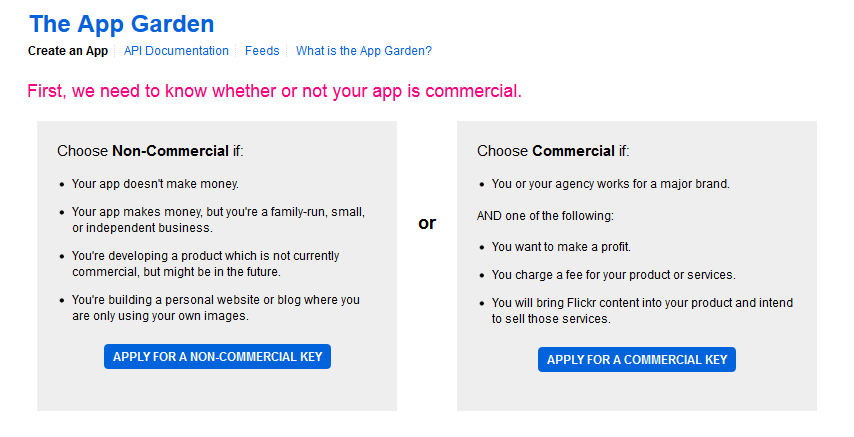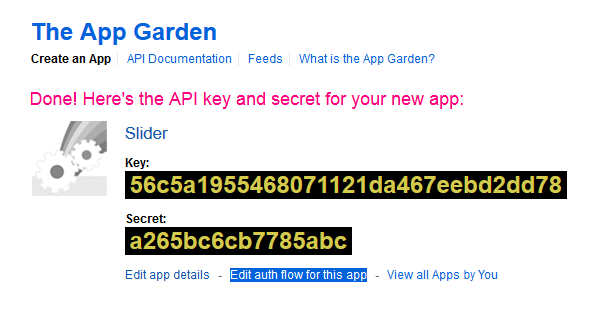Flickr generator
Tutorial
- 1
-
Go to this page on Flickr.
- 2
-
Click on Request an API Key.

- 3
-
Choose APPLY FOR A NON-COMMERCIAL KEY.

- 3
-
Give a name, some description to the API, and agree the terms.

- 4
-
Go to the Smart Slider's back-end Global Settings → Generators → Flickr, and copy out the Callback url.

- 5
-
Open the Edit auth flow for this app link in a new window, because you will need the information from this page.

- 6
-
Paste the Callback URL into here, and click on SAVE CHANGES.

- 7
-
Go back to the Step 6 page (if you closed the page, click on View in the right side under Admin) and copy the Key and Secret.

- 8
-
Paste them to the Smart Slider's back-end Global Settings → Generators → Flickr. (Make sure, that you don't have any empty space characters in the end or beginning of them.)

- 9
-
Click on Request token, and authorize the linking to your account.

- 10
-
You will see the token appearing in your settings, and you should save on it.

- 11
-
Now the api is done, create a new dynamic slide
To get started, go to any Slider Settings page and add a new dynamic slide. Choose
Flickr. - 12
-
Configuring the generator
Set up your generator. Choose the settings you want. Popular options you probably want to configure: category where your content will be pulled from, or the number of slides you want to have.
You can also click on the View Records button to see the data you'll be creating your slide with.
When you're done, click on
Add. - 13
-
Editing the dynamic slide
After you saved your generator, you'll be redirected to the Slide Editor to set up the look of your slide. You can create your content by using variables.
Not sure what are the variables or how to use them? Learn how to work with variables.
Configuration
You can use these options to set what you want your generator to show.

Filter
My photostream
Privacy
You can choose to show only the public photos, but you can also choose to show from differently private images.
My album
Album
You can select one album from your albums.
My photogallery
Gallery
You can select one gallery from your galleries.
Search
User name or ID
The username or the ID of the user from who you want to get the images. If you leave it on "me", it will return your images.
Tags
You can search for tags separated with comma.
Search in title, description or tags
Photos who's title, description or tags contain the text will be returned.
Privacy
Return photos only matching a certain privacy level. This only applies if you call your own photos.
Type
The returned content type:
- photos, screenshots, and 'other' (all)
- photos only
- screenshots only
- 'other' only
- photos and screenshots
- screenshots and 'other'
- photos and 'other'
Generator Settings

Learn about the Generator Settings at the Generator Settings documentation.
Variables
These are the available variables you can use to build your dynamic slide content in the Slide Editor.
Not sure what are the variables or how to use them? Learn how to work with variables.
My photostream, My album, My photogallery
- image - Either the original, or the large version of the image.
- thumbnail - Either the medium, or the large version of the image.
- title - The title of the image.
- description - The description of the image.
- url - URL to the photostream.
- owner_username - The username of the image's owner.
- author_name - Either the real name, or the username of the image's owner.
- author_url - URL to the author.
- url_t url_s ... url_o - Different sizes of the image.
- owner - The owner of the image.
- dateupload - The upload date of the image.
- datetaken - The date, when the image was taken.
- ownername - The name of the image's owner.
- views - The number of views of the image.
- tags - The tags of the image.
- latitude - The latitude of the image.
- longitude - The longitude of the image.
Search
- image - The large size image.
- thumbnail - The small size image.
- title - The title of the image.
- url - Url to the image.
- url_b ... url_z/1 - Different sizes of the image. These are based on the uploaded images' sizes, if they were made or not, for example url_h is the biggest, but if you uploaded a small image, Flickr won't create that.
Common issues
- 1
-
Flickr images are rotated wrongly
Problem
On Flickr the portrait image is rotated upside down, but in the slider it appears on it's side.
Cause
Your image is probably only rotated by it's exif data, but that is not supported by browsers, so the browser doesn't rotate that image of yours, only Flickr does.
Solution
Use the url_l variable instead of the image variable, which is the large version of your image. The url_l and other url_X variables besides the url_o aren't returning the original image, but the image created by flickr, and flickr rotates this images in a way, that browsers are showing them correctly too.









